The new Mahindra Bolero City-Pikup adds new dimensions to the legacy pickup range. Prateek Pardeshi tests its mettle in the urban jungle.
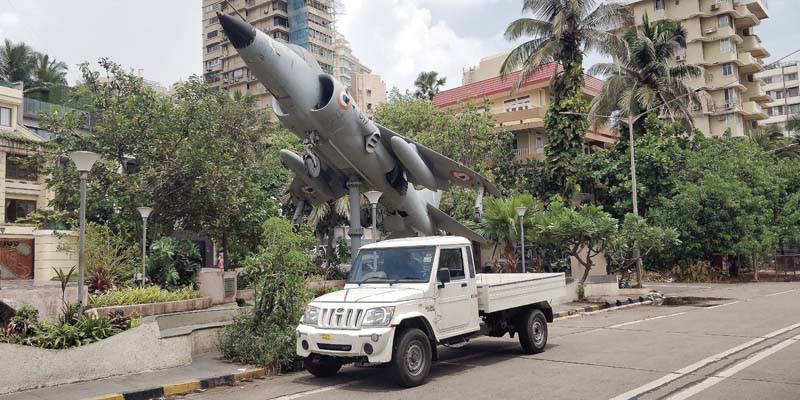 Mahindra & Mahindra (M&M) continues to dominate the pickup segment with the Bolero range. The Bolero Pickup is well known for catapulting M&M into a segment leader with a 59 per cent market share (FY2021-22) as it continues to diversify its customer offerings. The Original Equipment Manufacturer (OEM) is known to have sold 19,100 pickups on a Year-To-Date (YTD) basis including the new Bolero City Pikup. The new pickup carry’s the weight of being a workhorse with aplomb. We rode the 1.5-tonne (payload carrying capacity) variant that brings in well-thought-off improvements over its predecessors. These additions and subtractions meant, that Mahindra continues to reach out to its target groups, from small fleet operators to large fleet operators. It will be interesting to see how 2022 is pitted with the sales of 21,800 units in 2021 and 18,000 units in the pandemic marred 2020 where essential goods services were exempted from lockdowns to keep the wheels rolling.
Mahindra & Mahindra (M&M) continues to dominate the pickup segment with the Bolero range. The Bolero Pickup is well known for catapulting M&M into a segment leader with a 59 per cent market share (FY2021-22) as it continues to diversify its customer offerings. The Original Equipment Manufacturer (OEM) is known to have sold 19,100 pickups on a Year-To-Date (YTD) basis including the new Bolero City Pikup. The new pickup carry’s the weight of being a workhorse with aplomb. We rode the 1.5-tonne (payload carrying capacity) variant that brings in well-thought-off improvements over its predecessors. These additions and subtractions meant, that Mahindra continues to reach out to its target groups, from small fleet operators to large fleet operators. It will be interesting to see how 2022 is pitted with the sales of 21,800 units in 2021 and 18,000 units in the pandemic marred 2020 where essential goods services were exempted from lockdowns to keep the wheels rolling.

From assembling 75 Jeeps in the Completely Knocked Down (CKD) state in the late 1940s has the company today carving a niche for itself in the Utility Vehicles (UV) segment and for good reason. A visit to the Kandivali facility here in the western suburbs of Mumbai with Boleros doing the rounds of the premise and the specially built test track are testimony. This latest addition with the pickup aimed at intracity duty cycles undoubtedly retains the workhorse DNA and is a clear attempt at building on the learnings gathered from the predecessors up to the Bolero pickup in the Bharat Stage VI (BSVI) avataar. the Bolero roots can be traced back to the year 2000. Notably, the growth of UVs is also credited to the backing of the business unit, Mahindra and Mahindra Financial Services Ltd. (MMFSL).
On offer for intracity transportation
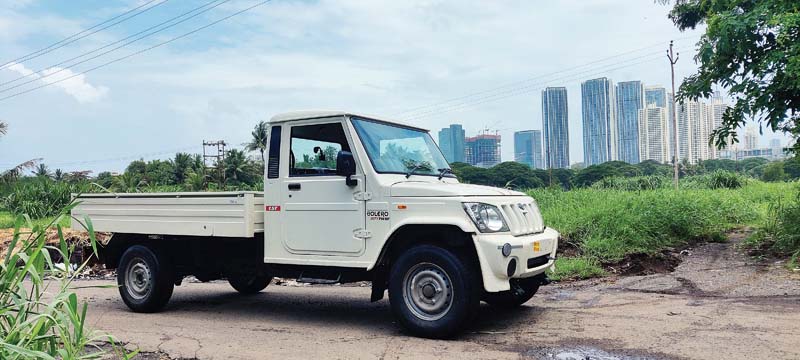 Leveraging the well-received, Bolero Extra Long also known as the big Bolero pickup and the Bolero Extra Strong, the new city pickup is designed as a compact and convenient option. Harish Lalchandani, VP-Marketing, Mahindra Automotive cites the constant endeavour to engineer and deliver best-in-class products measuring up on metrics like performance, reliability, and profitability and credits it for the continued dominance over the last two decades.
Leveraging the well-received, Bolero Extra Long also known as the big Bolero pickup and the Bolero Extra Strong, the new city pickup is designed as a compact and convenient option. Harish Lalchandani, VP-Marketing, Mahindra Automotive cites the constant endeavour to engineer and deliver best-in-class products measuring up on metrics like performance, reliability, and profitability and credits it for the continued dominance over the last two decades.
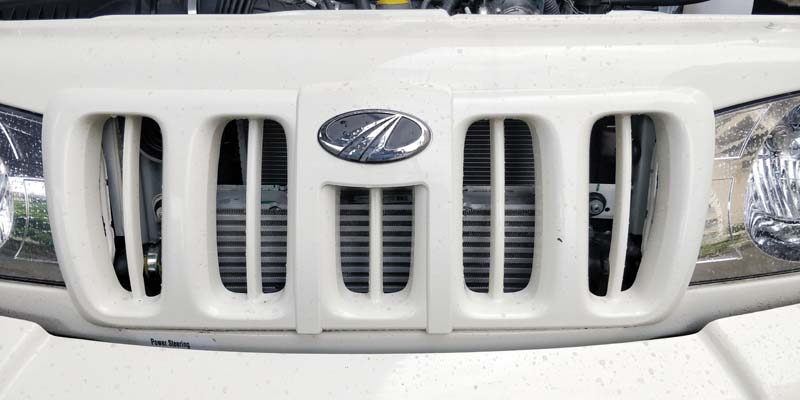
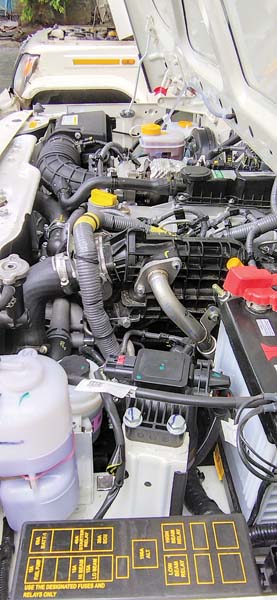 The pickup stands out with its reduced, overall dimensions of 4990 mm length as a result of a slimmer B-pillar and compact load tray. It measures 1700 mm in width and 1858 mm in height with a 3264 mm wheelbase that stays unchanged. This has a direct bearing on the turning radius, lowered as a result of the structural modifications making it more than just a cosmetic change.
The pickup stands out with its reduced, overall dimensions of 4990 mm length as a result of a slimmer B-pillar and compact load tray. It measures 1700 mm in width and 1858 mm in height with a 3264 mm wheelbase that stays unchanged. This has a direct bearing on the turning radius, lowered as a result of the structural modifications making it more than just a cosmetic change.
We parked it alongside the 2018, 1.7-tonne BSVI Bolero Pik-up FlatBed (FB) XL to look at it with a closer lens. The front from close quarters gave way to changes including a redesigned front bumper with the mudguard integrated. Resembling the latter (Bolero Pikup FB) on most counts, the new clear-lens headlamps opt out of the amber extensions on the corner of the lens. The signature slat grille is now body painted giving it a more contemporary appeal. Unlike on the SUVs, the old emblem continues on the CV. The arrangement of the reflectors and the fog lights is more spread out in comparison. Get past the bonnet and slide up to the windshield and the unchanged set of wiper blades greet you. It features the spray nozzle which could be a bone of contention for some.
 Walkover to the side and the single-door cab on the port side leaves out unnecessary alterations including the footrest for easy ingress. It’s the fins on the B-pillar that let the cat out of the bag on the reduction. We noticed the two hinged doors tend to trap the seat fabric given the scope of abuse in daily use. Move up to the rear and the distinctly compact cargo tray measures 2640 mm in length, 1700 mm in width, and 398 mm in height. The 3.09-tonne Gross Vehicular Weight (GVW) pickup is left with a payload carrying capacity of 1.5-tonne which might push operators towards the 1.7-tonner given that even the latter is known to be overloaded. For example, vegetable vendors visit the mandis to source fresh produce in the wee hours of the morning and have built closed containers out of the load tray to meet their requirements.
Walkover to the side and the single-door cab on the port side leaves out unnecessary alterations including the footrest for easy ingress. It’s the fins on the B-pillar that let the cat out of the bag on the reduction. We noticed the two hinged doors tend to trap the seat fabric given the scope of abuse in daily use. Move up to the rear and the distinctly compact cargo tray measures 2640 mm in length, 1700 mm in width, and 398 mm in height. The 3.09-tonne Gross Vehicular Weight (GVW) pickup is left with a payload carrying capacity of 1.5-tonne which might push operators towards the 1.7-tonner given that even the latter is known to be overloaded. For example, vegetable vendors visit the mandis to source fresh produce in the wee hours of the morning and have built closed containers out of the load tray to meet their requirements.
With Turn-Around-Time (TAT) and Total Cost of Operations (TCO) at the forefront of decision-making for Sawant. A vegetable vendor operating in the western suburbs of Mumbai, Sawant owns a fleet of three vehicles that includes two Mahindra Bolero Pikups. The new truck had a lot going for him barring the prospect of lowered laden weight. Appreciating the changes and the carryovers alike, Sawant wished for the same package in the 1.7-tonne guise given his daily payload requirement. Operators like Sawant know what they want! Some ticks for the operator included the fuel tank mount on the starboard with a 45-litre holding capacity.
The pickup plys on 215/75 R15 LT profile tyres. The vehicle retains its DNA at the rear end to the given way by the carryover; taillights are conventional and still use old generation of bulbs; three hinges are provided, allowing the tailgate to pivot almost 180 degrees sans stoppers resulting in a rattling sound. The rear is home to two new reverse parking sensors holding an uncanny resemblance to the Mahindra Supro. It makes use of two-stage beepers that alert the pilot when critical proximity is reached. The stepney is visible when you peek-a-boo from underneath the load tray making way for easy access. it also hints at the well accepted departure angle.
In-cabin
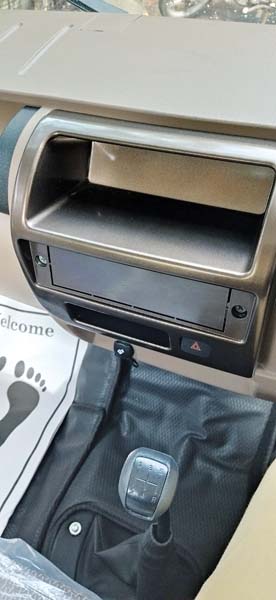 Step into the cabin of the Bolero city pikup and you are greeted by the three-spoke steering that offers a solid grip and lends to the commanding stance. It absorbs a great deal of fatigue from city and motorway driving with improved ergonomics. The thumb rest will be well appreciated over a long drive. The Driver plus 1 (D+1) seating arrangement is well spaced out with good leg room and under-thigh support with a clear view looking over the bonnet. One might sense the need for a headrest though. Given its pedigree and the temptation to steer off-road or tackle the challenging tarmac within city limits, the pikup does well with the leaf spring arrangement.Grab handles especially for the copilot would have been a good inclusion in addition to the one provided on the dash. Be it the speed bumpers, the water puddles and or loose soil, the pickup stays firmly grounded ensuring a well-rounded onroad performance. It allows the driver to push the pedal, especially in an unladen state!
Step into the cabin of the Bolero city pikup and you are greeted by the three-spoke steering that offers a solid grip and lends to the commanding stance. It absorbs a great deal of fatigue from city and motorway driving with improved ergonomics. The thumb rest will be well appreciated over a long drive. The Driver plus 1 (D+1) seating arrangement is well spaced out with good leg room and under-thigh support with a clear view looking over the bonnet. One might sense the need for a headrest though. Given its pedigree and the temptation to steer off-road or tackle the challenging tarmac within city limits, the pikup does well with the leaf spring arrangement.Grab handles especially for the copilot would have been a good inclusion in addition to the one provided on the dash. Be it the speed bumpers, the water puddles and or loose soil, the pickup stays firmly grounded ensuring a well-rounded onroad performance. It allows the driver to push the pedal, especially in an unladen state!
Not the most crucial consideration for operators in the segment, the two-tone coffee and beige trims are inviting. A 12V charging socket, optional HVAC, cubby holes and the inclusion of a flooring mat on the demo model brought in from Mahindra dealership Salasar Autocrafts Pvt. Ltd. we rode stacked up as the must-haves. A fixed glass seethrough cavity allows the operator to oversee cargo and reverse. Some might miss the flexibility that comes with a sliding glass frame especially with the aircon turned off.
Under the hood
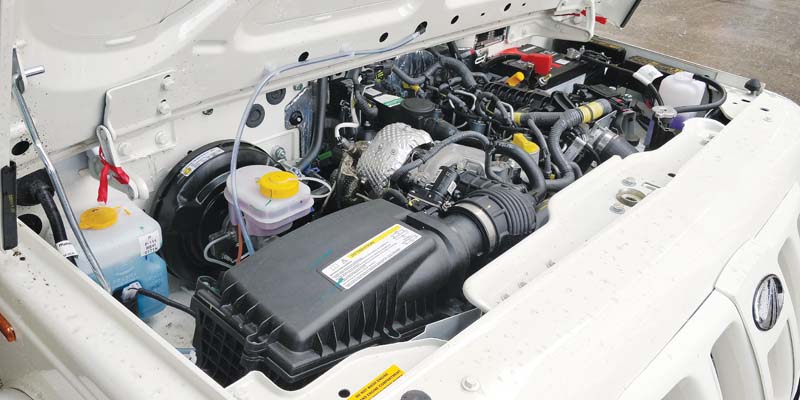 The pickup draws power from the four-cylinder, BSVI m2DiCR DI Turbo Charged, 2523 cc engine with a peak rated power of 65hp at 3200 rpm and a peak rated torque of 195 Nm in the 1400-2200 rpm range. The engine is mated to a five-speed manual transmission unit gearbox. The OEM is claimed to have improved the engine on counts of the installation of a new turbo and intercooler visible from the first glance of the front fascia and as a result an improved efficiency. The air filter is rectangular instead of circular one. This ensures maximum airflow back into the engine. In some interesting changes, the in-cabin fuse boxes have been shifted to the co-pilot side from underneath the steering previously. There are stacks on the port side inside the bonnet as well for ease of maintenance. These cover the designated fuses and relays including the 15A fuel pump, 60A battery, 15A each for the high- and low-beam, a 40A starter relay, 30A ECU, and the 100A Alternator grouped together in a dedicated compartment.
The pickup draws power from the four-cylinder, BSVI m2DiCR DI Turbo Charged, 2523 cc engine with a peak rated power of 65hp at 3200 rpm and a peak rated torque of 195 Nm in the 1400-2200 rpm range. The engine is mated to a five-speed manual transmission unit gearbox. The OEM is claimed to have improved the engine on counts of the installation of a new turbo and intercooler visible from the first glance of the front fascia and as a result an improved efficiency. The air filter is rectangular instead of circular one. This ensures maximum airflow back into the engine. In some interesting changes, the in-cabin fuse boxes have been shifted to the co-pilot side from underneath the steering previously. There are stacks on the port side inside the bonnet as well for ease of maintenance. These cover the designated fuses and relays including the 15A fuel pump, 60A battery, 15A each for the high- and low-beam, a 40A starter relay, 30A ECU, and the 100A Alternator grouped together in a dedicated compartment.
Driveability
Driving the Bolero city pik-up was thrilling! Everything you expect from a pickup and the Bolero DNA. At the end of the day long drive across different terrains, it is safe to say the vehicle in its unladen state didn’t disappoint. The dynamics might change in the laden state but it is sure to hold its own. When driving, the company recommends to leave the turbocharged engine running for about a minute prior to start or stop. Other recommendations include engaging the reverse gear only after pressing the clutch pedal for three seconds. Turn on the ignition, and the instrument console gets cracking. The centre analogue speedo is flanked by digital fuel and temperature gauge on its left-hand side with other key indicators grouped on the right-hand side. All through the drive, it was easy to monitor.

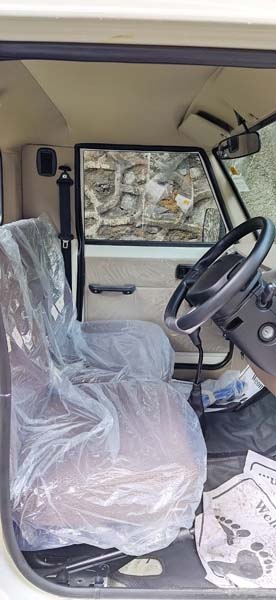 After the recommended idling, the vehicle took off with ease. Gear shifts were smooth and allowed us to breach the higher rpms and test the capability of the engine. On the highway, on breaching the 60-70 kmph mark, it was easy to shift into the top gear (fifth) and sense the engine running optimally. At this stage, the pilot is rest assured to be in cruise mode. Downward shifting from city limits was equally easy. From a safety drive perspective, the ORVMs might need to be coupled with aftermarket inclusions to increase the coverage of blind spots. A top mirror angled down to see the front wheel or a wide-angle mirror could be good supplementary additions, for example. While tackling an ascent, it took a while to get used to the hand brake positioning. Mounted in a confined space the pilot could feel the need for conventional hand brake placement near the gearshift. Add to it, the long and elevated stance of the clutch, brake and accelerator pedal arrangement takes time to get used to and may result in ankle sores for an Indian with an average height of five feet and eight inches.
After the recommended idling, the vehicle took off with ease. Gear shifts were smooth and allowed us to breach the higher rpms and test the capability of the engine. On the highway, on breaching the 60-70 kmph mark, it was easy to shift into the top gear (fifth) and sense the engine running optimally. At this stage, the pilot is rest assured to be in cruise mode. Downward shifting from city limits was equally easy. From a safety drive perspective, the ORVMs might need to be coupled with aftermarket inclusions to increase the coverage of blind spots. A top mirror angled down to see the front wheel or a wide-angle mirror could be good supplementary additions, for example. While tackling an ascent, it took a while to get used to the hand brake positioning. Mounted in a confined space the pilot could feel the need for conventional hand brake placement near the gearshift. Add to it, the long and elevated stance of the clutch, brake and accelerator pedal arrangement takes time to get used to and may result in ankle sores for an Indian with an average height of five feet and eight inches.
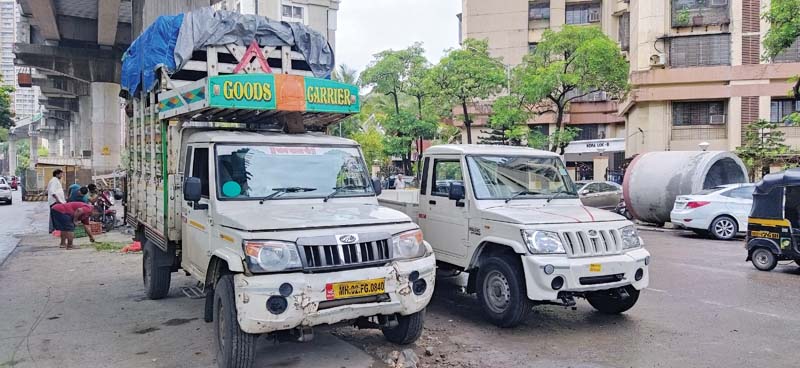 The long gear ratios meant the shifter travelled a fair amount too. When seated with a copilot, this could be a cause of discomfort, especially when engaging the second, fourth or reverse gear. The overall shift and vehicle response compensates a fair bit for it though. Driving in heavy downpour towards SoBo from the western suburbs meant that the single washer spray on the windshield was put to test. For a heavy-duty vehicle like the Bolero pickup, we felt the two-nozzle spray would have been more apt. All and all, operators looking at a lower TCO and quicker TAT courtesy a powerful and fine-tuned machine at hand have a new choice in the new Bolero City Pik-up an already proven lineup. The electric variant is around the corner too!
The long gear ratios meant the shifter travelled a fair amount too. When seated with a copilot, this could be a cause of discomfort, especially when engaging the second, fourth or reverse gear. The overall shift and vehicle response compensates a fair bit for it though. Driving in heavy downpour towards SoBo from the western suburbs meant that the single washer spray on the windshield was put to test. For a heavy-duty vehicle like the Bolero pickup, we felt the two-nozzle spray would have been more apt. All and all, operators looking at a lower TCO and quicker TAT courtesy a powerful and fine-tuned machine at hand have a new choice in the new Bolero City Pik-up an already proven lineup. The electric variant is around the corner too!



















